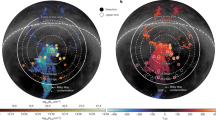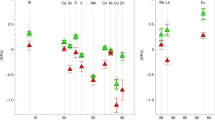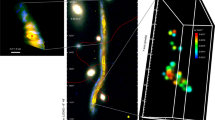Abstract
Pluto and its satellite, Charon (discovered in 1978; ref. 1), appear to form a double planet, rather than a hierarchical planet/satellite couple. Charon is about half Pluto's size and about one-eighth its mass. The precise radii of Pluto and Charon have remained uncertain, leading to large uncertainties on their densities2. Although stellar occultations by Charon are in principle a powerful way of measuring its size, they are rare, as the satellite subtends less than 0.3 microradians (0.06 arcsec) on the sky. One occultation (in 1980) yielded a lower limit of 600 km for the satellite's radius3, which was later refined to 601.5 km (ref. 4). Here we report observations from a multi-station stellar occultation by Charon, which we use to derive a radius, RC = 603.6 ± 1.4 km (1σ), and a density of ρ = 1.71 ± 0.08 g cm-3. This occultation also provides upper limits of 110 and 15 (3σ) nanobar for an atmosphere around Charon, assuming respectively a pure nitrogen or pure methane atmosphere.
This is a preview of subscription content, access via your institution
Access options
Subscribe to this journal
Receive 51 print issues and online access
$199.00 per year
only $3.90 per issue
Buy this article
- Purchase on Springer Link
- Instant access to full article PDF
Prices may be subject to local taxes which are calculated during checkout


Similar content being viewed by others
References
Christy, J. W. & Harrington, R. S. The satellite of Pluto. Astron. J. 83, 1005–1008 (1978)
Olkin, C. B., Wasserman, L. H. & Franz, O. G. The mass ratio of Charon to Pluto from Hubble Space telescope astrometry with the fine guidance sensors. Icarus 164, 254–259 (2003)
Walker, A. R. An occultation by Charon. Mon. Not. R. Astron. Soc. 192, 47P–50P (1980)
Elliot, J. L. & Young, L. A. Limits on the radius and a possible atmosphere of Charon from its 1980 stellar occultation. Icarus 89, 244–254 (1991)
Stern, S. A. The Pluto-Charon system. Annu. Rev. Astron. Astrophys. 30, 185–233 (1992)
Tholen, D. J. & Buie, M. W. in Pluto and Charon (eds Stern, S. A. & Tholen, D. J.) 193–219 (Univ. Arizona Press, Tucson, 1997)
Reinsch, K., Burwitz, V. & Festou, M. C. Albedo maps of Pluto and improved physical parameters of the Pluto-Charon system. Icarus 108, 209–218 (1994)
Tholen, D. J. & Buie, M. W. Further analysis of the Pluto-Charon mutual event observations. Bull. Am. Astron. Soc. 22, 1129 (1990)
Buratti, B. J. et al. Modeling Pluto-Charon mutual events. II. CCD observations with the 60 in. telescope at Palomar Mountain. Astron. J. 110, 1405–1419 (1995)
Young, E. F. & Binzel, R. P. A new determination of radii and limb parameters for Pluto and Charon from mutual events lightcurves. Icarus 108, 219–224 (1994)
Null, G. W. & Owen, W. M. Jr Charon/Pluto mass ratio obtained with HST CCD observations in 1991 and 1993. Astron. J. 111, 1368–1381 (1996)
Tholen, D. J. & Buie, M. W. The orbit of Charon. I. New Hubble Space Telescope observations. Icarus 125, 245–260 (1997)
Stansberry, J. A., Lunine, J. I., Hubbard, W. B., Yelle, R. V. & Hunten, D. M. Mirages and the nature of Pluto's atmosphere. Icarus 111, 503–513 (1994)
Yelle, R. V. & Elliot, J. L. in Pluto and Charon (eds Stern, S. A. & Tholen, D. J.) 347–390 (Univ. Arizona Press, Tucson, 1997)
McKinnon, W. B., Simonelli, S. P. & Schubert, G. in Pluto and Charon (eds Stern, S. A. & Tholen, D. J.) 295–343 (Univ. Arizona Press, Tucson, 1997)
Canup, R. M. A giant impact origin of Pluto-Charon. Science 307, 546–550 (2005)
Gurwell, M. A. & Butler, B. J. Sub-arcsec scale imaging of the Pluto/Charon binary system at 1.4 mm. Bull. Am. Astron. Soc. 37, 743 (2005)
Dumas, C., Terrile, R. J., Brown, R. H., Schneider, G. & Smith, B. A. Hubble Space Telescope NICMOS spectroscopy of Charon's leading and trailing hemispheres. Astron. J. 121, 1163–1170 (2001)
Acknowledgements
We thank the Conseil Scientifique of the Paris Observatory and the Programme National de Planétologie for supporting part of the observations of this event in South America.
Author information
Authors and Affiliations
Corresponding author
Ethics declarations
Competing interests
Reprints and permissions information is available at npg.nature.com/reprintsandpermissions. The authors declare no competing financial interests.
Rights and permissions
About this article
Cite this article
Sicardy, B., Bellucci, A., Gendron, E. et al. Charon's size and an upper limit on its atmosphere from a stellar occultation. Nature 439, 52–54 (2006). https://doi.org/10.1038/nature04351
Received:
Accepted:
Issue Date:
DOI: https://doi.org/10.1038/nature04351
Comments
By submitting a comment you agree to abide by our Terms and Community Guidelines. If you find something abusive or that does not comply with our terms or guidelines please flag it as inappropriate.



